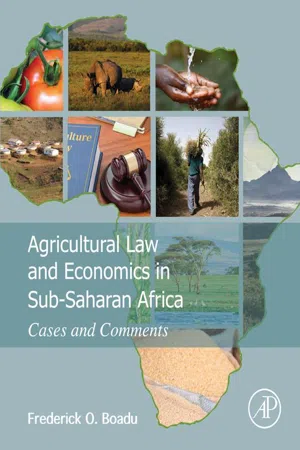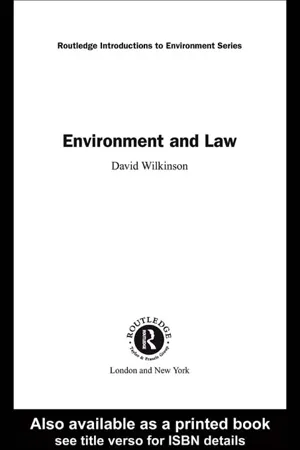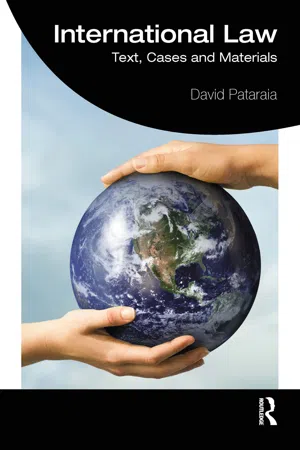Law
Environmental Law
Environmental law refers to a set of regulations and statutes that aim to protect the environment and natural resources. It encompasses a wide range of issues such as air and water quality, waste management, and conservation of natural habitats. Environmental law governs the interaction between human activities and the natural world, aiming to promote sustainable practices and minimize environmental harm.
Written by Perlego with AI-assistance
Related key terms
Related key terms
1 of 4
Related key terms
1 of 3
7 Key excerpts on "Environmental Law"
- eBook - ePub
- Paulo Campanha Santana(Author)
- 2023(Publication Date)
- Lisbon(Publisher)
The following issue is presented for the present work: what is the relationship between Natural Environmental Law and Environmental Labor Law? The methodology will be eminently descriptive, exploratory, substantiated in bibliographical research - legal system, doctrine, and jurisprudence. The hypothesis to be demonstrated is that the Environmental Labor Law and the Natural Environmental Law are the main pillars of the Environmental Law, as it was the work of human beings with nature that created the machine, which gave rise to industrialization, from which emerged urbanization (Artificial Environmental Law). This sequence has led us to date and currently puts humanity and planet Earth at risk. Therefore, between Environmental Labor Law and Natural Environmental Law, there is a dialectical relationship of interdependence that will give rise to effects on Environmental Law.2. Environmental LawEnvironmental Law involves a trans-individual safeguard, as its main objective is to protect the destiny of humanity. Therefore, it regulates the conduct of individuals or legal entities that threaten or affect, potentially or effectively, directly or indirectly, the environment in all its species.The preservation and protection of all forms of life are the epicenters of Environmental Law. Its principles, rules, and institutes establish solidarity of all civil society and the state so that the environment is ecologically balanced, guaranteed for present and future generations.Paulo Affonso Leme Machado elaborates the following concept on Environmental Law:Environmental Law is a systematizing law that articulates legislation, doctrine, and jurisprudence concerning the environment's elements. It seeks to avoid the isolation of environmental issues and their confrontational approach. It is no longer a question of building a Water Law, an Atmospheric Law, a Land Law, a Forest Law, a Fauna Law, or a Biodiversity Law. Environmental Law does not ignore what is specific to each subject but seeks to interconnect these themes with the mortar of the identity of legal instruments for prevention and repair, information, monitoring, and participation (MACHADO, 2012, p. 62).The environment encompasses the physical, biological, and chemical factors that surround all forms of life on Earth, and among all these elements, there is an interaction and mutual interdependence.The right to a balanced environment is provided for in art. 225 of the Constitution of the Republic is a fundamental right of the 3rd generation, of common use and public order, essential to a healthy quality of life, imposing on the state and the community the duty to defend and preserve it for the present and future generations. - eBook - ePub
Agricultural Law and Economics in Sub-Saharan Africa
Cases and Comments
- Frederick Owusu Boadu(Author)
- 2016(Publication Date)
- Academic Press(Publisher)
2 These laws are often found in constitutions, enactments by a Parliament, and Treaties. There are also several customary practices, norms, and community rules to protect the environment in SSA countries.15.2 Environmental Law and Economics
Environmental Law and economics refers to the use of economic tools in designing laws and regulations to study how humans impact the earth and its resources.3 From a macroeconomics perspective, economic tools may be used to study how different tax and subsidy laws, regulations, and policies promote a healthy environment. At the microeconomic level, economic tools may be used to study how laws and regulations influence the behavior of firms and households to achieve a predictable environmental impact outcome. Environmental Laws and regulations in both developed and developing countries vary in their emphases, complexity, and stringency given the diversity of the backgrounds of countries. A single generally accepted taxonomy of Environmental Laws and regulations is not possible given the complex Environmental Laws and regulations in different countries.15.3 The Law and Regulatory Scheme
Environmental Laws and regulations in SSA may be organized under three main categories: (1) pollution laws such as water, air, and noise control laws and regulations4 ; (2) laws protecting nature such as forest and wildlife laws5 ; and (3) product regulation laws such as pesticide and labeling laws and regulations.6 There are common unifying themes in all three categories. For example, laws and regulations covering the three categories are found in both the national laws of countries, and also in the large number of multilateral, bilateral, and regional environmental treaties to which these countries are parties.7 Participation in international treaties helps countries to acquire technical knowledge, expertise, and financial support for domestic programs to improve the environment. Another unifying theme is that the primary sources of Environmental Laws and regulations are the constitutions of countries.8 Also, all countries have a designated agency responsible for the overall implementation of Environmental Laws and regulations.9 - eBook - ePub
- Peter P. Rogers, Kazi F. Jalal, John A. Boyd(Authors)
- 2012(Publication Date)
- Routledge(Publisher)
To consider these reforms and developments, we first need to examine some of the basic concepts of international law as well as obstacles to the implementation of some of the key MEAs. We need to make such an examination because we want to find out how polluting states can be made to obey rules established outside their borders, and how polluting states unable to clean up their activities due to local politics can be compelled to do so by international law. We also need to explore how activists can use local and international courts to advance international Environmental Law standards, and we must examine, briefly, the evolution, from the legal point of view, of the concept of sustainable development, plus recent legislative developments to implement this concept.To begin our review of some of the basic concepts arising in the context of international law and legislation, let us consider the following four questions:• Did the Declaration of the United Nations Conference on the Human Environment in 1972, also known as the Stockholm Declaration, which helped establish UNEP as a key initiator of international environmental action, “create” or “develop” international Environmental Law?• When the UN General Assembly passed two resolutions in 1974, entitled “Declaration on the Establishment of a New International Economic Order” and “Charter of Economic Rights and Duties of States,” did it “create” or “develop” international Environmental Law?• Did the UNCED in Rio de Janeiro in 1992 “create” or “develop” international Environmental Law when it adopted Agenda 21 and the Rio Declaration on Environment and Development? • Is “sustainable development” a general principle of international law? DEFINITIONS To answer these questions we will first consider the definitions of law, international law, and environment. 1. LawThe Oxford English Reference Dictionary (1996, p. 810) defines law as “a rule enacted or customary in a community, and recognized as enjoining or prohibiting certain actions, and enforced by the imposition of penalties.” Note that this definition includes those rules that are “customary in a community” as well as those that are enacted. In Gorky Incident - eBook - ePub
- David Wilkinson(Author)
- 2005(Publication Date)
- Routledge(Publisher)
Principles of Environmental Law- The nature of legal principles
- The preventative principle
- The precautionary principle
- The polluter pays principle
Protection of the environment is, increasingly, seen as a question of ‘principle’. Frequently, one reads or hears references to phrases such as ‘the precautionary principle’ or the ‘polluter pays principle’. Often, in the context of developed versus developing states references are made to principles of ‘environmental justice’ and ‘sustainable development’. This chapter explores the role of legal principles in relation to environmental protection, and examines in further detail individual environmental principles such as the precautionary principle.The nature of legal principles
A principle is ‘a source of action’ or ‘a general law or rule adopted or professed as a guide to action’ (Oxford English Dictionary). It differs in three ways (Perry 1997) from a rule:- Rules operate in an all or nothing fashion. If a case falls within the conditions of application for a rule, then the rule must be applied (i.e. it is conclusive). Principles, by contrast, have the quality of ‘weight’ or importance.
- Rules specify a course of action to be followed or avoided. Principles, by contrast, are about values and cannot, therefore, indicate particular actions.
- Rules can be justified by principles, but the reverse is not true (Moore 1997).
Cheng (1953, 376) makes a similar point in relation to international law: a rule of law is a ‘practical formulation of the principles’ and the ‘application of the principle to the infinitely varying circumstances of practical life [which] aims at bringing about substantive justice in every case’.The great advantage of legal principles is that, given their general or nonparticularised nature, they have the flexibility to deal with novel and complex situations, and to act as general guides to action. Yet this flexibility implies some unpredictability. Sometimes principles are seen as possessing unquantifiable legal obligations. For this reason developed countries have not always supported the inclusion of environmental principles in treaties and other legislation. The US, in particular, was opposed to the inclusion of general environmental principles in the 1992 Climate Change Convention, fearing the creation of obligations and commitments of uncertain dimensions. On the other hand states sometimes perceive principles as weaker than (hence preferable to) strict rules or standards. The UK, also, made a declaration upon signature of the 1992 Biological Diversity Convention stating that the obligation in Article 3 of that convention – prohibiting transboundary harm – was one of principle, implying that this created no firm legal obligation (Sands 1995, 185). - eBook - ePub
International Law
Text, Cases and Materials
- David Pataraia(Author)
- 2021(Publication Date)
- Routledge(Publisher)
102. There are important deficiencies with respect to principles of international Environmental Law, in particular with respect to their content and legal status. There are instances where there is no clarity as to the nature and content of a principle, or no judicial consensus as to its applicability, or no recognition in binding legal instruments, or all of the above. The degree of legal uncertainty surrounding many of these principles has a direct and indirect impact on the predictability and implementation of sectoral environmental regimes. Some principles, such as access to information, participation in decision-making and access to justice, have only regional application. Others, such as a right to a clean and healthy environment and the principles of non-regression and progression, have only recently, and only in a limited number of legal instruments, been recognized and have not yet been fully developed. Although the principles of sustainable development and common but differentiated responsibilities and respective capabilities are inherently dynamic and flexible enough to allow international law to grow and respond to new challenges, their general application is hardly evident. There is a need to further clarify the principles of Environmental Law, without prejudice to the legal developments already achieved in the issue-specific contexts of various multilateral environmental agreements. A comprehensive and unifying international instrument that gathers all the principles of Environmental Law could provide for better harmonization, predictability and certainty.103. International Environmental Law is characterized by fragmentation and a general lack of coherence and synergy among a large body of sectoral regulatory frameworks. This fragmentation is inevitable given the piecemeal, incremental and reactive nature of international Environmental Law-making. However, deliberate efforts will be required to harness the interlinkages and synergies inherent in specific areas such as biodiversity, atmosphere or chemicals and wastes. The governance structure of international Environmental Law corresponds to its fragmentation. A multiplicity of institutions have responsibilities and mandates with respect to the environment, including institutions of the United Nations system, treaty -based bodies established by multilateral environmental agreements and specialized agencies, as well as regional institutions. This institutional fragmentation requires better coordination at both the law-making and implementation levels in order to ensure policy coherence, mutual supportiveness and synergies in implementation. There is, however, an important coordination deficit within the United Nations system, between United Nations system institutions and multilateral environmental agreements, among multilateral environmental agreements and between multilateral environmental agreements and other environment-related instruments. Strengthened coordination and coherence could enhance the effectiveness of international Environmental Law. - eBook - ePub
- Jonathan Z. Cannon(Author)
- 2015(Publication Date)
- Harvard University Press(Publisher)
CHAPTER TWOEnvironmental Law, the Court, and Interpretation
FROM THE LATE 1960S through the early 1980s, environmentalism generated an astounding wave of new and demanding legislation in the United States at the federal level, with comparable activity in some states. It also gave rise to new institutions, such as the U.S. Environmental Protection Agency (EPA), to implement and enforce these laws. These innovations have proved remarkably durable, despite political efforts to weaken them or wipe them away. Many environmentalists, however, question whether Environmental Laws have fulfilled their promise. At one level this is a question about whether these laws have achieved sufficient protections and whether those protections can survive in the future under hostile pressure. More deeply, the question is whether these laws advance the cultural change that environmentalists seek or whether they are only marginal adjustments to an essentially unchanged social, economic, and political system. The Environmental Laws enacted during this period, both in number and content, suggested for many a sea change—a fundamental altering of how people in this country saw themselves in relation to their physical environment and to each other—but the cultural portent of these laws has weakened over time, partly as a result of political and judicial responses that have constrained their expression.This chapter illustrates the transformational promise of these laws and sets the stage for our examination of the Supreme Court’s role in advancing or checking their fulfillment. The Court represents a distinct law culture, but the Court is also shaped by the ambient culture and helps shape it in kind. While purporting to follow neutral principles of legal analysis, the decisions of the Supreme Court—or some of them—reflect the Court’s response to conflicts in the ambient culture. In the Court’s most culturally salient environmental decisions, the clash of values and beliefs implicit in the cases spills into the judicial opinions, often revealing intense differences in the worldviews of the justices themselves. - eBook - ePub
Sustainability
Life Chances and Livelihoods
- Michael Redclift(Author)
- 2002(Publication Date)
- Routledge(Publisher)
public recognition of ecocentric and biocentric values. Environmental harm is a matter for the community requiring communal decision-making, not ‘individual consumers expressing personal wants’ (Freyfogle 1994:843).If ecological law is inconsistent with classical liberal theory then other, non-liberal, theories will have to provide its jurisprudential underpinnings. ‘Natural law’ theories appear, appropriately, to hold considerable promise in this matter. The notion that human affairs are properly ordered when they accord to an underlying and pre-existing ‘natural’ order is one which appeals to many environmentalists. On this view we should order our affairs with nature according to ‘ecological practicable reasonableness’ (after Finnis 1980). On this view the preservation of the planetary life-support system, the reduction of the global human population, the strict control of human eco-destructive activities, the legal embodiment of inherent ecological values, would all properly be considered to be goals which any coherent and effective body of law must strive to achieve. Natural law jurisprudence would imply that laws should ‘be chosen according to an ideal goal or good, rather than represent the haphazard implementation of voters’ preferences, be they popular, or those of specific interest groups’ (Westra 1993). In this jurisprudence we would expect to see an increase in judicial activism (Dias 1994) and the development of new legal principles to guide the evolution of the law in novel matters and statutory interpretation.Ecological law and democratic theory
The desirability of democratic participation in the formulation and enforcement of Environmental Law is usually taken as a given by environmentalists. However, we should not assume that democracy is implicit in, and can be derived from, environmental ethics: this would be to confuse theories of value (about nature) with theories of agency (how to act politically) (Goodin 1992). Ethics are determined not by what is popular, but by what is good, right or virtuous. Popular support, especially local support, for policies that are environmentally destructive but which provide tangible short-term benefits is to be expected in a world of self-interested individuals. Democracy cannot, therefore, be identified as a green ‘good’ to be ranked alongside other green values.
Index pages curate the most relevant extracts from our library of academic textbooks. They’ve been created using an in-house natural language model (NLM), each adding context and meaning to key research topics.
Explore more topic indexes
Explore more topic indexes
1 of 6
Explore more topic indexes
1 of 4






